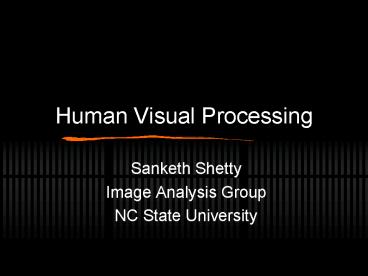Human Visual Processing PowerPoint PPT Presentation
1 / 43
Title: Human Visual Processing
1
Human Visual Processing
- Sanketh Shetty
- Image Analysis Group
- NC State University
2
Overview
- Structure of the system
- Retina
- Lateral Geniculate Nucleus
- Superior Colliculus
- Primary Visual Cortex
- Higher Visual Areas (later)
3
Visual Field
4
Three Layers
- Receptors ( Rods and Cones)
- Bipolar Cells
- Horizontal and Amacrine Cells
- Retinal Ganglion Cells
5
The Retina
6
Receptors
- Rods
- More numerous
- Concentrated on Periphery
- More sensitive to Light (dark vision)
- Long and slender
- Only one type of pigment
7
- Cones
- Concentrated in the fovea (0.5 mm in di)
- Daylight vision
- Also responsible for color vision (3 types of
pigments) (Wald at Harvard first proposed the
bleaching theory) - Short and tapered
- Receptors are normally active and when light
falls on them they are hyperpolarized.
8
The Retina
9
Second layer
- Bipolars
- Horizontal
- Amacrine Cells
10
Bipolars
- Involved in both Direct and indirect paths
- Center Surround Structure that is reflected onto
the Retinal Ganglion Cells. - Activity in terms of transmitter release
- Surround gt Horizontal Cells
11
The Retina
12
Retinal Ganglion Cells
- First look at receptive fields
- 1251 reduction
- Direct and indirect paths from receptors
13
Parvo and Magno Ganglion Cells
- Center Surround
- Small receptive fields
- Low contrast sensitivity
- High Spatial acuity
- Low Speed
- Center Surround and Center only
- Large RF
- High Contrast Sensitivities
- Low Spatial Acuity
- High Speed (SC)
14
Receptive Fields of Ganglion Cells
- Fire irregular but steady pulses in dark or
diffuse light. - 2 types of Cells
- On Center
- Off Center
- Center Surround Structure
15
Center Surround Structure
- Smallest in the fovea and largest in the
periphery.
16
A Look at the Structure
Topographic
17
Lateral Geniculate Nucleus
- Each receives inputs from Ganglion Cells
- Receives inputs from Higher Cortical Areas
(dynamic receptive fields) - Intra-region connections also exist
18
Layers of the LGN
- Alternating R-L
- Dorsal Parvo (ganglion cells) top 4 layers
- Ventral Magno (ganglion cells) bottom 2 layers
- Same Center Surround Receptive Field.
19
Superior Colliculus
- Magno cells input
- Feedback from higher cortical areas
- Quick to respond
- Sensitive to luminance changes in time and space
- Junction box for interaction between senses
- Projects directly to V5 (MT and FEF)
- Constantly updates new information (does not feed
to V1)
20
Primary Visual Cortex
- Architecture
- Three types of Cells
- Simple
- Complex
- End Stopped
21
Architecture of the Visual Cortex
- Area 17
- Area 17 gt Area 18 (V2)
- Area 18 projects to
- Medial Temporal
- V3
- V4
22
Area 17 (Striate Cortex)
- The richest connections run vertically
- Very little horizontal or diagonal spreading
- The analysis in V1 is local
- Not the seat of perception
- Architecture is complex (No details for now)
23
Overview
24
Simple Cells
- No longer Center Surround
- Spatial Summation
- Respond best to an optimally oriented stationary
slit that lies within the receptive field - Smallest in the foveal region
- Sensitive to spatial frequency also. (De Valois
and De Valois) - How are they constructed?
25
One possibility
26
Complex Cells
- 75 of cortical cells
- Orientation Specific
- Respond only in a receptive field
- Not responsive to stationary slits or spots
shining on them. - Motion Sensitive
- Sometimes sensitive to only one direction of
motion (20 of cells in the striate)
27
Directional Sensitivity (Barlow-Levicks Model)
28
More on how we see
- 75 of cells in the V1 are tuned to Motion
- How do we see stationary scenes?
- Saccades
- Micro-saccades
- Stationary Scenes disappear (if we stabilize the
image on the retina)
29
End Stopping
- Spatial Summation (only over fixed space)
- Possibly constructed from Simple cells. Complex
Cell architecture is also possible - Optimal response
- Curve with appropriate orientation within
- Appropriately oriented line of fixed length
30
Patterns in V1
- Ocular Dominance Columns
- Orientation Columns
31
Orientation Columns
- Vertically same orientation preference (except
layer 4Cß) - Horizontally the preference changes by 10 degrees
every 0.05mm
32
Visual Processing
- 2mm x 2mm area of cortex
- Complete processing of one area of VF
- Layer 3 (layer 4 has 4x4)
- In each module (hyper column) corresponding to
each area in the VF - Orientation
- Eye dominance
33
(No Transcript)
34
Orientation Columns
- 400 degrees per mm
35
Magnification
- Fovea
- 1 degree of VF maps to 6mm on cortex
- Periphery
- 1 degree of VF maps to 0.15mm on cortex
36
Disproportionate Representation
37
Looking Ahead
- 2 Parts of the Visual Stream
- Ventral Stream (V1gtIT)
- Objects, Shapes, Color, Texture
- Dorsal Stream(V1gtMTgtPC)
- Visual Information, Position, Movement, Action
38
The Where and What Streams
39
Visual Hierarchy
- Dorsal and Ventral Streams arent independent
- The visual information flows 2 ways
- It needs to emphasize
- What it is looking at (to the Dorsal)
- Where it is (to the Ventral)
40
More about the Visual Streams
- Speed
- Time
- Feedback, horizontal and feed forward connections
- Dynamic Receptive Fields
41
What we need to look into
- The Ventral Path (V1 and IT)
- Significance of Feedback to our algorithm
42
Resources
- Eye, Brain and Vision by Dr. David Hubel
- The Thinking Eye, The Seeing Brain by James Enns
- We need to look at Topographica/LISSOM (from
University of Texas at Austin)
43
The End
- Images courtesy Dr.Hubels Homepage

